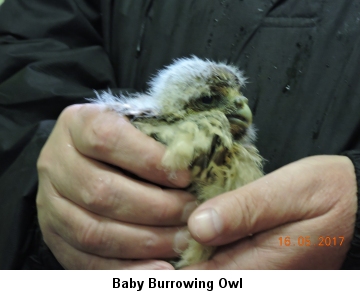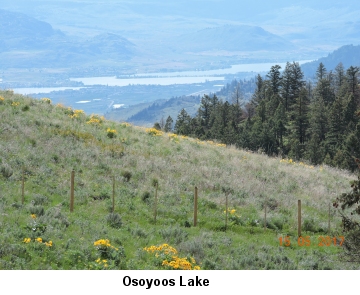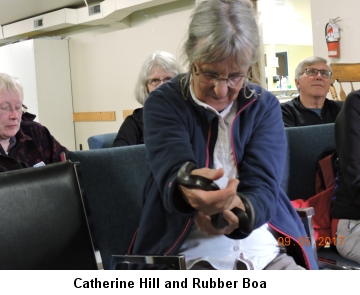1. The South Okanagan
by John Neville
This article first appeared in the fall edition of BC Nature 2017
We are going to take a trip along Highway 97 from the US border.
This road creates a route north through the center of British Columbia. We are in search of nature.
"Nature in the common sense refers to essences unchanged by man: space, the air, the river, the leaf."
(from Nature by Ralph Waldo Emerson, 1836.)
 Spring, says the encyclopedia Britannica, is the season of the year following winter and preceding summer, but it is much more.
There is a definite change happening with the celestial bodies above us, which is felt by nature.
Its all due to the 23.5 *(degree) tilt of the earth in relationship to the sun.
Yet it is much more: migrating birds arrive to nest, plants produce leaves, flowers and fruit,
and farmers have high expectations for their crops. The warming of the earth brings bears out of
their dens and the increasing light stimulates people to do spring cleaning.
We will enjoy the dry Okanagan valley in the rain-shadow of the coastal mountains.
Spring, says the encyclopedia Britannica, is the season of the year following winter and preceding summer, but it is much more.
There is a definite change happening with the celestial bodies above us, which is felt by nature.
Its all due to the 23.5 *(degree) tilt of the earth in relationship to the sun.
Yet it is much more: migrating birds arrive to nest, plants produce leaves, flowers and fruit,
and farmers have high expectations for their crops. The warming of the earth brings bears out of
their dens and the increasing light stimulates people to do spring cleaning.
We will enjoy the dry Okanagan valley in the rain-shadow of the coastal mountains.
We treated the junction of highway 3 with 97 as kilometer zero, like The Okanagan Valley Birding Trail sponsored by BC Nature, and the BC Bird Finding books by Richard and Russell Cannings and Keith Taylor. Our first stop was the campground at Haynes Point Provincial Park a little more than 2 kilometers south. The small park occupies a glacial sand spit reaching into the middle Osoyoos Lake. It's was May 14th and the wind was creating waves next to our site. The Tree Swallows were busy in the Cottonwoods using old woodpecker holes. On other occasions Great Horned owls have visited our site and a single Coyote called from across the lake. There is a marsh at the beginning of the spit where Redwings were calling. Once, in March I recorded the whispering sounds of an eagle’s wings as it flew over me and descended into the old cat-tails. It took a Ring-necked Pheasant after a deadly struggle. The lake is only 283 m. above sea level. However, today it is higher covering the beach up to the Poison Ivy. Osprey, Red-neck Grebe and California Quail all added to our memories of the point.  We headed west from the junction on highway 3. The guide books directed us to a gravel road, on the right at 11.2 km, onto Mount Kobau.
The turning is next Spotted Lake. As the road ascended amongst the Sagebrush we were able to listen to the music of Meadowlarks.
The Violet-green Swallows were hawking overhead and a Red-tailed Hawk was soaring in the sunshine.
In contrast to the light green Sagebrush there were scattered bunches of blooming yellow Arrow-leaved Balsamroot.
Further up the mountain, past cliffs and Sagebrush, the views of Osoyoos Lake became more dramatic.
Juncos, Flickers and Vesper's Sparrow were added to the growing number of birds we passed.
We headed west from the junction on highway 3. The guide books directed us to a gravel road, on the right at 11.2 km, onto Mount Kobau.
The turning is next Spotted Lake. As the road ascended amongst the Sagebrush we were able to listen to the music of Meadowlarks.
The Violet-green Swallows were hawking overhead and a Red-tailed Hawk was soaring in the sunshine.
In contrast to the light green Sagebrush there were scattered bunches of blooming yellow Arrow-leaved Balsamroot.
Further up the mountain, past cliffs and Sagebrush, the views of Osoyoos Lake became more dramatic.
Juncos, Flickers and Vesper's Sparrow were added to the growing number of birds we passed.
David Pitt-Brooke in Crossing Home Ground, uses his discerning eye to observe: "All that open ground should be covered in bunchgrass. It isn't. Instead it mostly supports a close-packed mass of big sagebrush, a sure indication of intense, chronic overgrazing''. At about 10 km. we passed through a recent burn of Douglas Firs. At 14 km. we reached the snow line and decided to turn around. At the bottom we stopped for the Spotted Lake sign which read in part: "From time immemorial it's healing waters and mud were used by first nations to cure aches and illness, and for spiritual healing. High concentrations of Epsom salts, calcium, sodium sulphates, and trace minerals such as silver and titanium are found in this unusual lake." 3 km. north on highway 97, brings you to a left hand turn off, and another half kilometer to the Desert Center. It's a great place to learn about the Antelope Brush Ecosystem. An excellent 1.5 km. boardwalk takes you to many plants and information signs. The twig-like branches of the Antelope-bush have light colored leaves to reflect sunlight and hairs to capture moisture. Bunchgrass stems grow in clusters, or tube-shapes to funnel any rain straight down to the roots. The Biotic Crust keeps the vegetation alive in the desert by retaining moisture for the plants, transferring nutrients into the sandy soil and holding seeds for germination. Only 4% of Canada's Pocket Desert is currently preserved and the remainder is quickly being used up by agriculture and urbanization. On the 16th, Bob Hanfield picked us up in his 4 wheel drive truck. He was taking us to the proposed National Park land around Kilpoola Lake. This time we travelled 6.8 km. west on highway 3, then turned left (or south) and left again on Old Richter Pass Road. Unfortunately, it was raining. This has been the norm for several weeks, resulting in extensive flooding around the Okanagan. Turtle Pond, Blue and Kilpoola Lakes were all bursting their banks. The extensive grasslands, Aspen and Douglas Fir woods and riparian vegetation were many bright shades of green. On the lower slopes the antelope-brush was showing small yellow flowers, while some of the yellow Balsamroot flowers were past their best. The Saskatoon bushes were in full white bloom. The Chokecherry were starting to bloom and the Lupins were close to opening. Bob mentioned there had been more than 40 wild flowers found in the area. Most of the land is currently protected to some extent by the Nature Conservancy, BC Parks, the Nature Trust and parcels of Crown land. The lack of real protection was brought home to us when we came across a couple, shoveling the Biotic Crust into their truck for topsoil for their garden. Standing on a ridge, looking south into the Similkameen River Valley, even in the rain, the unspoiled bunch grass, the songs from Meadowlarks and Brewer's Sparrow were unforgettable. Part 2: aqppears in the winter magazine BC Nature 2017 Now we are really starting to travel north on 97! At 7.8 km. we turned right (east) onto Road 22, directly north of Osoyoos Lake. There have been some very welcome changes, or should I say reversals in the river recently. Breaching the old dykes to allow the oxbows to form again is a wonderful improvement. Walking along the new dyke we appreciated three kinds of blackbirds plus Sora, Goldfinch, and Song Sparrows. Two Turkey Vultures were perched at the top of a tree, wings outstretched enjoying the morning sun, just like ourselves. There was an interesting low fence along highway 97, which directs wildlife towards the culverts under the road. I think that's a real plus for BC highways. We headed east to Haynes' Lease Ecological Reserve. We were greeted by extensive fields of Antelope-brush and Brittle Prickly-pear Cactus. It was very windy along the cliff “The Throne” with only a few swallows and meadowlarks. In the past I have recorded Chuckar, White-throated Swift and Say's Phoebe along that rock wall. The Okanagan Nation have taken the lead in releasing small Sockeye Salmon back into the river. They are using a hatchery in the Shushwap. The returns up the Columbia and Okanagan rivers has been significant. Some fish are now reaching Skaha Lake in good numbers! For the last few years the numbers have increased from a low of about 10 thousand to 3 or 4 hundred thousand, per annum. This has allowed the Okanagan Nation to hold a fishery for about one half of the returns. The next northerly turn is at about 20 km. in Oliver at the third set of lights by the Esso station. Turn right (east) onto Fairview Road, cross the river, and right again onto McKinney Road. This is a great Sagebrush and pine forest birding area. I didn't find the illusive White-headed Woodpecker or the Grey Flycatcher but I did make a nice recording of a Dusky Flycatcher. I also discovered that Ponderosa Pine have male and female cones. As we continued north on 97, the valley narrows down. We crossed another river bridge, Inkaneep Provincial Park on the right and McIntyre Bluffs on the left. We turned right at 32 km. to visit the Burrowing Owl Conservation Society of BC. Lauren Meads met us and showed us around. This year 34 young owls have been raised. They will all be released next spring in the Nicola and Okanagan Valleys. After migrating to various western states for the winter, previous releases have been quite encouraging. Three years ago 60 returned, last year 42, and so far 20 have been counted this year. Four years ago I recorded one of the breeding males named Pilot, and immortalized his calls on Bird Songs of Canada. If you approach too close to the young owls they hiss, a close imitation of a Rattlesnake; a very impressive defense mechanism.  This reminded me of a talk we received at the Okanagan camp, by Stuart Brown. There are 7 species of snake in the Okanagan Valley.
The so called "infamous" Northern Pacific Rattlesnake is best known.
This animal is quite docile and never bites unless it is picked up, stepped on etc.
The snake which interested me most was the Rubber Boa. It gives birth to live young; is a constrictor;
does not eat at all for the first year of life; grows to about 1 m. long ; is olive-green in colour, nocturnal and not often observed.
The one I handled gave a modest squeeze to my forearm but seemed to be quite relaxed. They invade mouse nests to feed on the young.
The snakes tail can be raised to imitate its head. This is a defense mechanism. Stuart showed us a picture of momma mouse attacking its tail,
while the head end swallowed all of the young!
This reminded me of a talk we received at the Okanagan camp, by Stuart Brown. There are 7 species of snake in the Okanagan Valley.
The so called "infamous" Northern Pacific Rattlesnake is best known.
This animal is quite docile and never bites unless it is picked up, stepped on etc.
The snake which interested me most was the Rubber Boa. It gives birth to live young; is a constrictor;
does not eat at all for the first year of life; grows to about 1 m. long ; is olive-green in colour, nocturnal and not often observed.
The one I handled gave a modest squeeze to my forearm but seemed to be quite relaxed. They invade mouse nests to feed on the young.
The snakes tail can be raised to imitate its head. This is a defense mechanism. Stuart showed us a picture of momma mouse attacking its tail,
while the head end swallowed all of the young!
There is a good car park on the west side of the road at Vaseaux Lake approximately 34 km from the starting point. This too is a proposed section for the National Park. There were excellent panels of information about IBA and valley information. Amongst the contributors BC Nature and our BC Naturalists Foundation were mentioned,. It's a very attractive boardwalk through the marsh to a beautiful look-out and blind. There were all the classic riparian warblers, blackbirds and sparrows, plus Tanagers, Marsh Wrens, Red-heads, Red-necked Grebe and more. There were a steady flow of people enjoying nature, including two Kelowna naturalists.  While visiting Doreen Olson we were reminded of the extensive bat numbers in the valley.
At dusk a number of Little Brown bats flew out from under her eves.
There are 16 bat species in BC and 14 of them can be found in the Okanagan.
When we drove down to the South Okanagan we stopped at the visitors center in Peachland.
They have a colony of bats nearly 2000 strong living in the attic. Their presence was unknown till renovations were being carried out.
The Little Brown myotis and Yuma myotis have become a tourist attraction, with a cam recorder available to see them roosting.
People take chairs and wait for them to flow out at dusk.
Each consumes between 600 and 1000 insects an hour! The largest bat in the valley, the Spotted Bat, eats moths and has a wingspan of 40 cm.
While visiting Doreen Olson we were reminded of the extensive bat numbers in the valley.
At dusk a number of Little Brown bats flew out from under her eves.
There are 16 bat species in BC and 14 of them can be found in the Okanagan.
When we drove down to the South Okanagan we stopped at the visitors center in Peachland.
They have a colony of bats nearly 2000 strong living in the attic. Their presence was unknown till renovations were being carried out.
The Little Brown myotis and Yuma myotis have become a tourist attraction, with a cam recorder available to see them roosting.
People take chairs and wait for them to flow out at dusk.
Each consumes between 600 and 1000 insects an hour! The largest bat in the valley, the Spotted Bat, eats moths and has a wingspan of 40 cm.
Our final visit was to the White Lake Basin. The turning onto White Lake Road came up on the left, (west), at 47 km. from the junction. There are excellent IBA signs and some very good information panels. 50 million year old fossils of Dawn Redwood leaves can be found in the rocks. The Nature Trust has implemented a Biodiversity Ranch policy. This seems to mean light grazing but not enough to attract invasive species. I was delighted to hear a Coyote family yipping as I recorded beautiful Meadowlarks. This is the fourth area of the proposed National Park and it certainly is worth protecting for us all! |